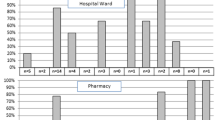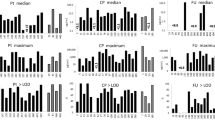Abstract
Despite the classification as known or suspected human carcinogens, by the International Agency for Research on Cancer, the antineoplastic drugs are extensively used in cancer treatment due to their specificity and efficacy. As human carcinogens, these drugs represent a serious threat to the healthcare workers involved in their preparation and administration. This work aims to contribute to better characterize the occupational exposure of healthcare professionals to antineoplastic drugs, by assessing workplace surfaces contamination of pharmacy and administration units of two Portuguese hospitals. Surface contamination was assessed by the determination of cyclophosphamide, 5-fluorouracil, and paclitaxel. These three drugs were used as surrogate markers for surfaces contamination by cytotoxic drugs. Wipe samples were taken and analyzed by HPLC-DAD. From the total of 327 analyzed samples, in 121 (37 %) was possible to detect and quantify at least one drug. Additionally, 28 samples (8.6 %) indicate contamination by more than one antineoplastic drug, mainly in the administration unit, in both hospitals. Considering the findings in both hospitals, specific measures should be taken, particularly those related with the promotion of good practices and safety procedures and also routine monitoring of surfaces contamination in order to guarantee the appliance of safety measures.
Similar content being viewed by others
References
Acampora, A., Castiglia, L., Miraglia, N., Pieri, M., Soave, C., Liotti, F., et al. (2005). A case study: surface contamination of cyclophosphamide due to working practices and cleaning procedures in two Italian hospitals. Annals of Occupational Hygiene, 49(7), 611–618.
Brouwers, E. E. M., Huitema, A. D. R., Bakker, E. N., Douma, J. W., Schimmel, K. J. M., van Weringh, G., et al. (2007). Monitoring of platinum surface contamination in seven Dutch hospital pharmacies using inductively coupled plasma mass spectrometry. International Archives of Occupational and Environmental Health, 80(8), 689–699.
Castiglia, L., Miraglia, N., Pieri, M., Simonelli, A., Basilicata, P., Genovese, G., et al. (2008). Evaluation of occupational exposure to antiblastic drugs in an Italian hospital oncological department. Journal of Occupational Health, 50, 48–56.
Cavallo, D., Ursini, C. L., Perniconi, B., Francesco, A. D., Giglio, M., Rubino, F. M., et al. (2005). Evaluation of genotoxic effects induced by exposure to antineoplastic drugs in lymphocytes and exfoliated buccal cells of oncology nurses and pharmacy employees. Mutation Research, 587(1–2), 45–51.
Connor, T. H., & McDiarmid, M. A. (2006). Preventing occupational exposures to antineoplastic drugs in health care settings. CA: A Cancer Journal for Clinicians, 56(6), 354–365.
Connor, T. H., Sessink, P. J., Harrison, B. R., Pretty, J. R., Peters, B. G., Alfaro, R. M., et al. (2005). Surface contamination of chemotherapy drug vials and evaluation of new vial-cleaning techniques: results of three studies. American Journal of Health-System Pharmacy, 62(5), 475–484.
Connor, T. H., DeBord, G., Pretty, J. R., Oliver, M. S., Roth, T. S. H., Lees, P. S., et al. (2010). Evaluation of antineoplastic drug exposure of health care workers at three university-based US cancer centers. JOEM, 52, 1019–1027.
Davis, J., McLauchlan, R., & Connor, T. H. (2011). Exposure to hazardous drugs in healthcare: an issue that will not go away. Journal of Oncology Pharmacy Practice, 17(1), 9–13.
Delporte, J. P., Chenoix, P., & Hubert, P. H. (1999). Chemical contamination of the primary packaging of 5-fluorouracil RTU solutions commercially available on the Belgian market. European Journal of Hospital Pharmacy, 5, 119–121.
Favier, B., Gilles, L., Ardiet, C., & Latour, J. F. (2003). External contamination of vials containing cytotoxic agents supplied by pharmaceutical manufacturers. Journal of Oncology Pharmacy Practice, 9, 15–20.
Fransman, W., Vermeulen, R., & Kromhout, H. (2004). Occupational dermal exposure to cyclophosphamide in Dutch hospitals: a pilot study. Annals of Occupational Hygiene, 48(3), 237–244.
Fransman, W., Vermeulen, R., & Kromhout, H. (2005). Dermal exposure to cyclophosphamide in hospitals during preparation, nursing and cleaning activities. International Archives of Occupational and Environmental Health, 78(5), 403–412.
Fransman, W., Peelen, S., Hilhorst, S., Roeleveld, N., Heederik, D., & Kromhout, H. (2007). A pooled analysis to study trends in exposure to antineoplastic drugs among nurses. Annals of Occupational Hygiene, 51(3), 231–239.
Fucic, A., Jazbec, A., Mijic, A., Seso-Simic, D., & Tomek, R. (1998). Cytogenetic consequences after occupational exposure to antineoplastic drugs. Mutation Research, 416(1–2), 59–66.
Hedmer, M., Jönsson, B. A. G., & Nygren, O. (2004). Development and validation of methods for environmental monitoring of cyclophosphamide in workplaces. Journal of Environmental Monitoring, 6, 979–984.
Hedmer, M., Georgiadi, A., Bremberg, E. R., Jönsson, B. A. G., & Eksborg, S. (2005). Surface contamination of cyclophosphamide packaging and surface contamination with antineoplastic drugs in a hospital pharmacy in Sweden. Annals of Occupational Hygiene, 49(7), 629–637a.
Hedmer, M., Tinnerberg, H., Axmon, A., & Jönsson, B. A. (2008). Environmental and biological monitoring of antineoplastic drugs in four workplaces in a Swedish hospital. International Archives of Occupational and Environmental Health, 81(7), 899–911.
Hirst, M., Tse, S., Mills, D. G., Levin, L., & White, D. F. (1984). Occupational exposure to cyclophosphamide. 1(8370), 186–188.
Hon, C. Y., Teschke, K., Chua, P., Venners, S., & Nakashima, L. (2011). Occupational exposure to antineoplastic drugs: identification of job categories potentially exposed throughout the hospital medication system. Safety and Health at Work, 2(3), 273–281.
Hon, C. Y., Teschke, K., Chu, W., Demers, P., & Venners, S. (2013). Antineoplastic drug contamination of surfaces throughout the hospital medication system in Canadian hospitals. Journal of Occupational and Environmental Hygiene, 10(7), 374–383.
Huang, Y. W., Jian, L., Zhang, M. B., Zhou, Q., Yan, X. F., Hua, X. D., et al. (2012). An investigation of oxidative DNA damage in pharmacy technicians exposed to antineoplastic drugs in two Chinese hospitals using the urinary 8-OHdG assay. Biomedical and Environmental Sciences, 25(1), 109–116.
International Agency for Research on Cancer (IARC). (2012). Monographs on the evaluation of carcinogenic risks to humans. Some antiviral and antineoplastic drugs, and other pharmaceutical agents. Lyon, France: IARC Available from http://monographs.iarc.fr. Accessed 25 Oct 2013.
International Society of Oncology Pharmacy Practitioners ISOPP. (2007). ISOPP standards of practice: safe handling of cytotoxics. Journal of Oncology Pharmacy Practice, 13(Suppl), 1–81.
Kiffmeyer, T. K., Tuerk, J., Hahn, M., Stuetzer, H., Hadtstein, C., Heinemann, A., et al. (2013). Application and assessment of a regular environmental monitoring of the antineoplastic drug contamination level in pharmacies—the MEWIP Project. Annals of Occupational Hygiene, 57(4), 444–455.
Kopjar, N., Garaj-Vrhovac, V., Kasuba, V., Rozgaj, R., Ramić, S., Pavlica, V., et al. (2009). Assessment of genotoxic risks in Croatian health care workers occupationally exposed to cytotoxic drugs: a multi-biomarker approach. International Journal of Hygiene and Environmental Health, 212(4), 414–431.
Kopp, B., Schierl, R., & Nowak, D. (2013). Evaluation of working practices and surface contamination with antineoplastic drugs in outpatient oncology health care settings. International Archives of Occupational and Environmental Health, 86(1), 47–55.
Kromhout, H., Hoek, F., Uitterhoeve, R., Huijbers, R., Overmars, R. F., Anzion, R., et al. (2000). Postulating a dermal pathway for exposure to anti-neoplastic drugs among hospital workers. Applying a conceptual model to the results of three workplace surveys. Annals of Occupational Hygiene, 44(7), 551–560.
Larson, R. R., Khazaeli, M. B., & Dillon, H. K. (2002). Monitoring method for surface contamination caused by selected antineoplastic agents. American Journal of Health-System Pharmacy, 59(3), 270–277.
Larson, R. R., Khazaeli, M. B., & Dillon, H. K. (2003). A new monitoring method using solid sorbent media for evaluation of airborne cyclophosphamide and other antineoplastic agents. Applied Occupational and Environmental Hygiene, 18(2), 120–131.
Mason, H. J., Morton, J., Garfitt, S. J., Iqbal, S., & Jones, K. (2003). Cytotoxic drug contamination on the outside of vials delivered to a hospital pharmacy. Annals of Occupational Hygiene, 47(8), 681–685.
Mason, H. J., Blair, S., Sams, C., Jones, K., Garfitt, S. J., Cuschieri, M. J., et al. (2005). Exposure to antineoplastic drugs in two UK hospital pharmacy units. Annals of Occupational Hygiene, 49(7), 603–610.
McDevitt, J. J., Lees, P. S., & McDiarmid, M. A. (1993). Exposure of hospital pharmacists and nurses to antineoplastic agents. Journal of Occupational Medicine, 35(1), 57–60.
Minoia, C., Turci, R., Sottani, C., Schiavi, A., Perbellini, L., Angeleri, S., et al. (1998). Application of high performance liquid chromatography/tandem mass spectrometry in the environmental and biological monitoring of health care personnel occupationally exposed to cyclophosphamide and ifosfamide. Rapid Communications in Mass Spectrometry, 12(20), 1485–1493.
Miyake, T., Iwamoto, T., Tanimura, M., & Okuda, M. (2013). Impact of closed-system drug transfer device on exposure of environment and healthcare provider to cyclophosphamide in Japanese hospital. SpringerPlus; 2: 273. Available from http://www.springerplus.com/content/2/1/273. Accessed 25 Oct 2010.
Nygren, O., Gustavsson, B., Ström, L., & Friberg, A. (2002). Cisplatin contamination observed on the outside of drug vials. Annals of Occupational Hygiene, 46(6), 555–557.
Schierl, R., Böhlandt, A., & Nowak, D. (2009). Guidance values for surface monitoring of antineoplastic drugs in German pharmacies. Annals of Occupational Hygiene, 53(7), 703–711.
Schmaus, G., Schierl, R., & Funck, S. (2002). Monitoring surface contamination by antineoplastic drugs using gas chromatography-mass spectrometry and voltammetry. American Journal of Health-System Pharmacy, 59(10), 956–961.
Sessink, P. J., Boer, K. A., Scheefhals, A. P., Anzion, R. B., & Bos, R. P. (1992). Occupational exposure to antineoplastic agents at several departments in a hospital. Environmental contamination and excretion of cyclophosphamide and ifosfamide in urine of exposed workers. International Archives of Occupational and Environmental Health, 64(2), 105–112.
Sessink, P. J., Van de Kerkhof, M. C., Anzion, R. B., Noordhoek, J., & Bos, R. P. (1994). Environmental contamination and assessment of exposure to anti-neoplastic agents by determination of cyclophosphamide in urine of exposed pharmacy technicians: is skin absorption an important exposure route? Archives of Environmental Health, 49(3), 165–169.
Shirato, S. (1992). Problems of cytotoxicity drug mainly based on antineoplastic tumor medicine. Japanese Journal of Medical Waste Research, 5, 1–32.
Sugiura, S., Asano, M., Kinoshita, K., Tanimura, M., & Nabeshima, T. (2011). Risks to health professionals from hazardous drugs in Japan: a pilot study of environmental and biological monitoring of occupational exposure to cyclophosphamide. Journal of Oncology Pharmacy Practice, 17(1), 14–19.
Touzin, K., Bussières, J. F., Langlois, E., & Lefebvre, M. (2009). Evaluation of surface contamination in a hospital hematology–oncology pharmacy. Journal of Oncology Pharmacy Practice, 15, 53–61.
Touzin, K., Bussières, J. F., Langlois, E., Lefebvre, M., & Métra, A. (2010). Pilot study comparing the efficacy of two cleaning techniques in reducing environmental contamination with cyclophosphamide. Annals of Occupational Hygiene, 54(3), 351–359.
Turci, R., Sottani, C., Spagnoli, G., & Minoia, C. (2003). Biological and environmental monitoring of hospital personnel exposed to antineoplastic agents: a review of analytical methods. Journal of Chromatography, B: Analytical Technologies in the Biomedical and Life Sciences, 789(2), 169–209.
Turci, R., Minoia, C., Sottani, C., Coghi, R., Severi, P., Castriotta, C., et al. (2011). Occupational exposure to antineoplastic drugs in seven Italian hospitals: the effect of quality assurance and adherence to guidelines. Journal of Oncology Pharmacy Practice, 17(4), 320–332. doi:10.1177/1078155210381931
Yang, T., Cui, F., Choi, M., Lin, H., Chung, S., Shim, C., & Kim, D. (2007). Liposome formulation of paclitaxel with enhanced solubility and stability. Drug Delivery, 14(5), 301–308.
Yoshida, J., Koda, S., Nishida, S., Nakano, H., Tei, G., & Kumagai, S. (2013). Association between occupational exposure and control measures for antineoplastic drugs in a pharmacy of a hospital. Annals of Occupational Hygiene, 57(2), 251–260.
Acknowledgments
The study would not have been possible to develop without the financial support given by Portuguese Authority of Working Conditions (Project reference: 036APJ/09).
Author information
Authors and Affiliations
Corresponding author
Rights and permissions
About this article
Cite this article
Viegas, S., Pádua, M., Veiga, A.C. et al. Antineoplastic drugs contamination of workplace surfaces in two Portuguese hospitals. Environ Monit Assess 186, 7807–7818 (2014). https://doi.org/10.1007/s10661-014-3969-1
Received:
Accepted:
Published:
Issue Date:
DOI: https://doi.org/10.1007/s10661-014-3969-1




